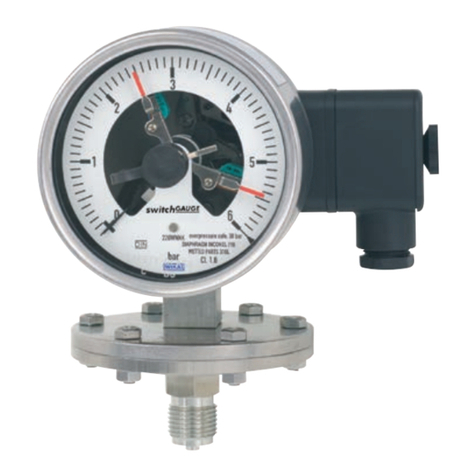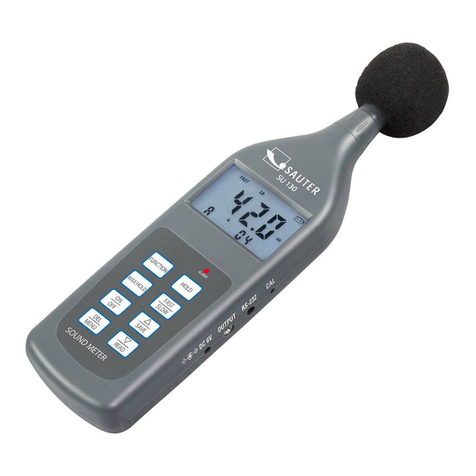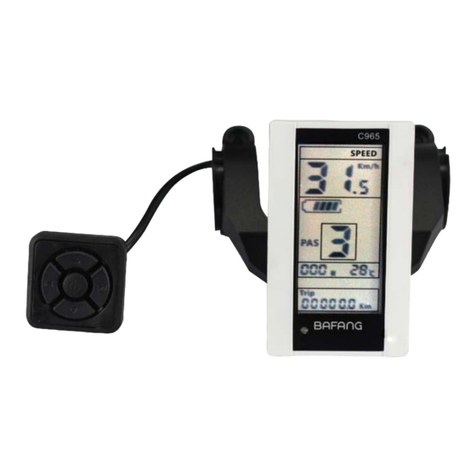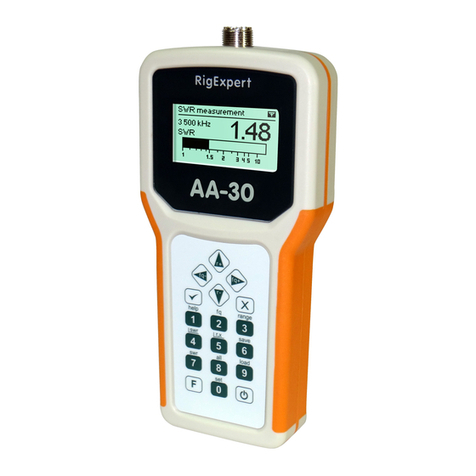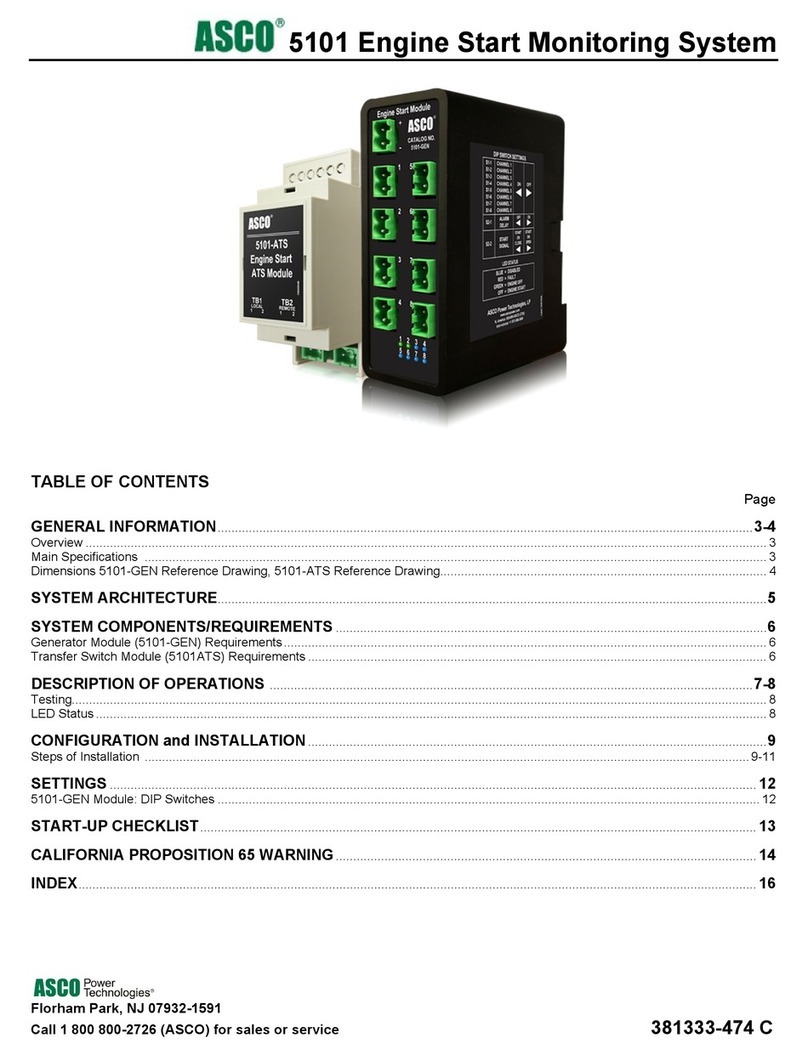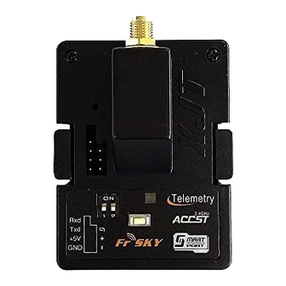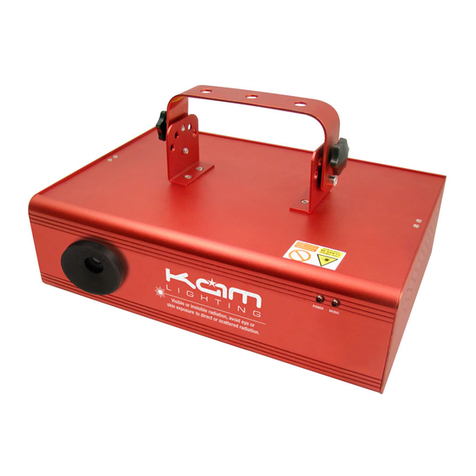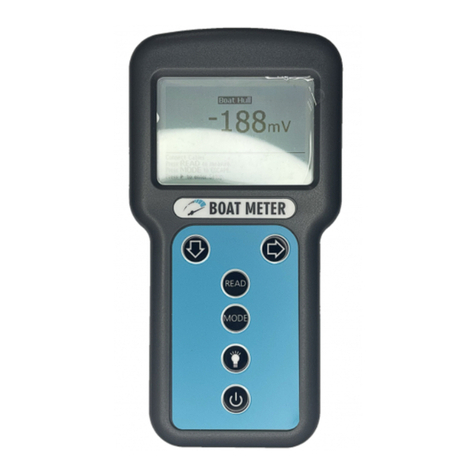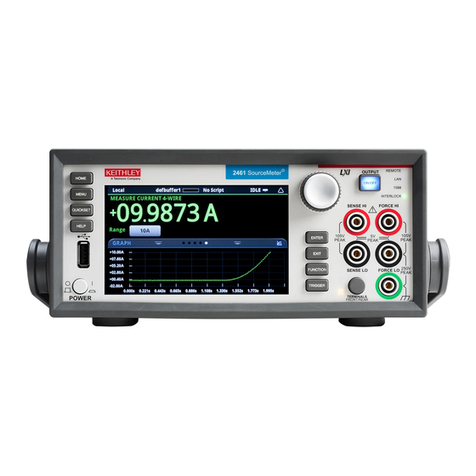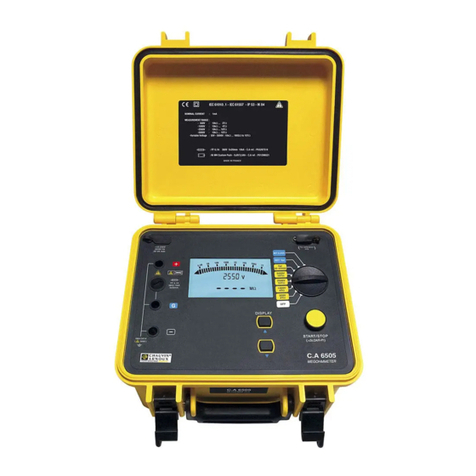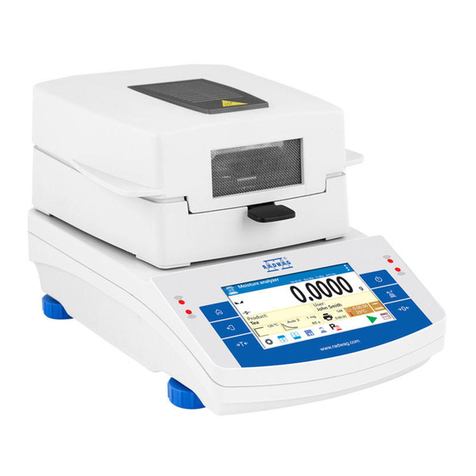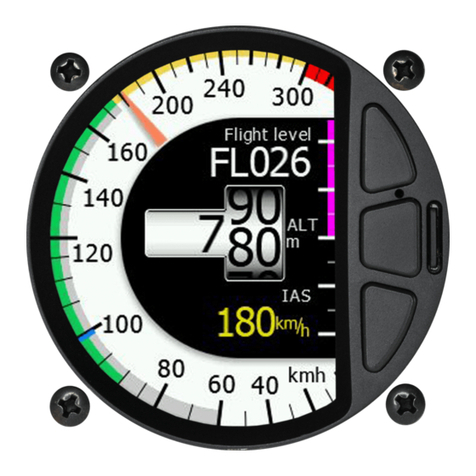IMI SENSORS PCB Piezotronics TO622B01 User manual

Model TO622B01
Platinum Precision Industrial ICP® Accelerometer
Installation and Operating Manual
For assistance with the operation of this product,
contact the PCB Piezotronics, Inc.
Toll-free: 800-959-4464
24-hour SensorLine: 716-684-0001
Fax: 716-684-3823
E-mail: [email protected]
Web: www.imi-sensors.com

The information contained in this document supersedes all similar information that
may be found elsewhere in this manual.
Service –Due to the sophisticated
nature of the sensors and associated
instrumentation provided by PCB
Piezotronics, user servicing or repair is
not recommended and, if attempted,
may void the factory warranty. Routine
maintenance, such as the cleaning of
electrical connectors, housings, and
mounting surfaces with solutions and
techniques that will not harm the
physical material of construction, is
acceptable. Caution should be observed
to ensure that liquids are not permitted
to migrate into devices that are not
hermetically sealed. Such devices
should only be wiped with a dampened
cloth and never submerged or have
liquids poured upon them.
Repair –In the event that equipment
becomes damaged or ceases to
operate, arrangements should be made
to return the equipment to PCB
Piezotronics for repair. User servicing or
repair is not recommended and, if
attempted, may void the factory
warranty.
Calibration –Routine calibration of
sensors and associated instrumentation
is recommended as this helps build
confidence in measurement accuracy
and acquired data. Equipment
calibration cycles are typically
established by the users own quality
regimen. When in doubt about a
calibration cycle, a good “rule of thumb”
is to recalibrate on an annual basis. It is
also good practice to recalibrate after
exposure to any severe temperature
extreme, shock, load, or other
environmental influence, or prior to any
critical test.
PCB Piezotronics maintains an ISO-
9001 certified metrology laboratory and
offers calibration services, which are
accredited by A2LA to ISO/IEC 17025,
with full traceability to SI through
N.I.S.T. In addition to the normally
supplied calibration, special testing is
also available, such as: sensitivity at
elevated or cryogenic temperatures,
phase response, extended high or low
frequency response, extended range,
leak testing, hydrostatic pressure
testing, and others. For information on
standard recalibration services or
special testing, contact your local PCB
Piezotronics distributor, sales
representative, or factory customer
service representative.
Returning Equipment –Following
these procedures will ensure that your
returned materials are handled in the
most expedient manner. Before
returning any equipment to PCB
Piezotronics, contact your local
distributor, sales representative, or
factory customer service representative
to obtain a Return Warranty, Service,
Repair, and Return Policies and
Instructions Materials Authorization
(RMA) Number. This RMA number
should be clearly marked on the outside
of all package(s) and on the packing
Service, Repair, and Return
Policies and Instructions

list(s) accompanying the shipment. A
detailed account of the nature of the
problem(s) being experienced with the
equipment should also be included
inside the package(s) containing any
returned materials.
A Purchase Order, included with the
returned materials, will expedite the
turn-around of serviced equipment. It is
recommended to include authorization
on the Purchase Order for PCB to
proceed with any repairs, as long as
they do not exceed 50% of the
replacement cost of the returned
item(s). PCB will provide a price
quotation or replacement
recommendation for any item whose
repair costs would exceed 50% of
replacement cost, or any item that is not
economically feasible to repair. For
routine calibration services, the
Purchase Order should include
authorization to proceed and return at
current pricing, which can be obtained
from a factory customer service
representative.
Contact Information –International
customers should direct all inquiries to
their local distributor or sales office. A
complete list of distributors and offices
can be found at www.pcb.com.
Customers within the United States may
contact their local sales representative
or a factory customer service
representative. A complete list of sales
representatives can be found at
www.pcb.com. Toll-free telephone
numbers for a factory customer service
representative, in the division
responsible for this product, can be
found on the title page at the front of this
manual. Our ship to address and
general contact numbers are:
PCB Piezotronics, Inc.
3425 Walden Ave.
Depew, NY14043 USA
Toll-free: (800) 828-8840
24-hour SensorLineSM: (716) 684-0001
Website: www.pcb.com

PCB工业监视和测量设备 - 中国RoHS2公布表
PCB Industrial Monitoring and Measuring Equipment - China RoHS 2 Disclosure Table
部件名称
有害物质
铅(Pb)
汞
(Hg)
镉
(Cd)
六价铬(Cr(VI))
多溴联苯 (PBB)
多溴二苯醚(PBDE)
住房
O
O
O
O
O
O
PCB板
X
O
O
O
O
O
电气连接器
O
O
O
O
O
O
压电晶体
X
O
O
O
O
O
环氧
O
O
O
O
O
O
铁氟龙
O
O
O
O
O
O
电子
O
O
O
O
O
O
厚膜基板
O
O
X
O
O
O
电线
O
O
O
O
O
O
电缆
X
O
O
O
O
O
塑料
O
O
O
O
O
O
焊接
X
O
O
O
O
O
铜合金/黄铜
X
O
O
O
O
O
本表格依据 SJ/T 11364 的规定编制。
O:表示该有害物质在该部件所有均质材料中的含量均在 GB/T 26572 规定的限量要求以下。
X:表示该有害物质至少在该部件的某一均质材料中的含量超出 GB/T 26572 规定的限量要求。
铅是欧洲RoHS指令2011/65/ EU附件三和附件四目前由于允许的豁免。
CHINA RoHS COMPLIANCE

DOCUMENT NUMBER: 21354
DOCUMENT REVISION: D
ECN: 46162
Component Name
Hazardous Substances
Lead
(Pb)
Mercury
(Hg)
Cadmium
(Cd)
Chromium VI
Compounds
(Cr(VI))
Polybrominated
Biphenyls
(PBB)
Polybrominated
Diphenyl
Ethers (PBDE)
Housing
O
O
O
O
O
O
PCB Board
X
O
O
O
O
O
Electrical
Connectors
O
O
O
O
O
O
Piezoelectric
Crystals
X
O
O
O
O
O
Epoxy
O
O
O
O
O
O
Teflon
O
O
O
O
O
O
Electronics
O
O
O
O
O
O
Thick Film
Substrate
O
O
X
O
O
O
Wires
O
O
O
O
O
O
Cables
X
O
O
O
O
O
Plastic
O
O
O
O
O
O
Solder
X
O
O
O
O
O
Copper Alloy/Brass
X
O
O
O
O
O
This table is prepared in accordance with the provisions of SJ/T 11364.
O: Indicates that said hazardous substance contained in all of the homogeneous materials for this part is below the limit
requirement of GB/T 26572.
X: Indicates that said hazardous substance contained in at least one of the homogeneous materials for this part is above
the limit requirement of GB/T 26572.
Lead is present due to allowed exemption in Annex III or Annex IV of the European RoHS Directive 2011/65/EU.

MANUAL NUMBER: 18405
MANUAL REVISION: A
ECN NUMBER: 49766
Operating Guide with Enclosed Warranty Information
3424 Walden Avenue, Depew, New York 14043-2495
Phone (716) 684-0003
Fax (716) 684-3823
Toll Free Line 1-800-959-4IMI
Piezoelectric ICP® Accelerometers Operating Guide

General
OPERATING GUIDE
for use with
PIEZOELECTRIC ICP® ACCELEROMETERS
SPECIFICATION SHEET, INSTALLATION DRAWING AND CALIBRATION INFORMATION ENCLOSED
IMI ASSUMES NO RESPONSIBILITY FOR DAMAGE CAUSED TO THIS PRODUCT AS A RESULT OF
PROCEDURES THAT ARE INCONSISTENT WITH THIS OPERATING GUIDE
1.0 INTRODUCTION
Congratulations on the purchase of a quality ICP®
industrial sensor. In order to ensure the highest level of
performance for this product, it is imperative that you
properly familiarize yourself with the correct mounting
and installation techniques before attempting to
operate this device. If, after reading this manual, you
have any additional questions concerning this sensor or
its application, feel free to call an Application Engineer
at 716-684-0003 or 800-959-4464.
Proper sensor selection requires special attention to
three main areas: sensor design, dynamic
expectations, and application environment.
Sensor design encompasses the actual sensing
element, the physical material, and component
selection for the sensor. Preferred industrial
accelerometers employ a shear sensing element
with either a quartz or ceramic crystal.
Quartz sensing elements are typically used when
long-term stability and minimum output shifts due
to temperature changes are desired. Ceramic
sensing elements provide excellent resolution and
durability in noisy environments, and can be
designed to supply low-frequency and high-
frequency measurements. Shear-design sensors are
preferred because of their inherent insensitivity to
adverse environmental influences, such as case or
base strain and thermal transients. Internal case
isolation and shielding is important in avoiding
erroneous signals resulting from ground loops
and pick-up of electromagnetic and radio
frequency interference. Other critical material
selection criteria include non-magnetic stainless
steel housing, hermetic sealing, and industrial
military connectors. See Figure 1.
Dynamic expectations are application-specific and
refer to the frequency range of measurement and the
anticipated amplitudes of vibration. After careful
review of the machinery to be monitored, minimum
and maximum measurement frequency ranges may
be established. The minimum measurement
frequency is normally relatedto any sub-harmonics of
running speed or any lower frequencies where
vibration data is to be collected. The maximum
measurement frequency of interest is determined by
the maximum number of harmonics of an event like
running speed, bearing frequencies, or gear mesh.
This measurement frequency range should be well
within the specified frequency range of the sensor.
Amplitude range refers to the anticipated levels of
vibration to be measured. These values are related
to the alarm levels set for the machine. By carefully
evaluating the idiosyncrasies of the machinery, the
predictive maintenance engineer can estimate the
minimum expected vibration levels and ensure that
the electrical noise floor of the accelerometer is less
than those levels.

The environment of the application is a critical
consideration during program implementation. The
sensor chosen must be capable of surviving the wide
range of conditions to which it is subjected;
therefore, take time to evaluate potential
conditions, such as high temperatures and chemical
contaminants. The specified temperature range of
the sensor must conform to the fluctuations of the
environmental temperature. If harsh industrial
chemicals are present, the sensor requires hermetic
sealing and construction that resists corrosion.
Finally, specific location of the sensor within the
environment must be sensible, as both cable and
sensor may be damaged by imprudent installation in
heavily traveled, physically punishing areas.
2.0 ICP® ACCELEROMETERS
Enclosed in the back of this guide is a Specification
Sheet, which lists the complete performance
characteristics of the particular sensor.
All ICP® sensors require a constant current power
source for proper operation. A typical sensing
system includes an ICP® sensor, ordinary two
conductor cable and a basic constant current power
supply (as shown in Figure 2).
The signal conditioner consists of a well-regulated 18
to 30 VDC source (battery or line-powered), a
current-regulating diode (or equivalent constant
current circuit), and a capacitor for decoupling
(removing the bias voltage) the signal.
The current-regulating device is used in place of a
resistor for several reasons. The very high dynamic
resistance of the diode yields a source follower gain
which is extremely close to unity and independent of
input voltage. Also, the diode can be changed to supply
higher currents for driving long cable lengths. Constant
current diodes, as shown in Figure 3, should be used in
ICP® signal conditioners. (The correct orientation of the
diode within the circuit is critical for proper operation.)
Except for special models, standard ICP® sensors require
a minimum of 2 mA for proper operation.
The typical limits for this type of diode are to a 4 mA
maximum rating; however, several diodes can be placed in
parallel for higher current levels. All line-powered signal
conditioners should use higher capacity (up to 20 mA)
constant current circuits in place of the diodes, particularly
when driving long signalcables (see Section 5).
Decoupling of the data signal occurs at the output stage
of the signal conditioner. A 10 to 30 µF capacitor coupled
with a resistor shifts the signal level to essentially
eliminate the sensor bias voltage. The result is a drift-free
AC mode of operation.
3.0 OPTIONAL FEATURES
In addition to standard features, a variety of options
are also available. When listed before the model
number, the following prefix letters indicate that the
sensor is manufactured or supplied with optional
features:
CS - Canadian Standards Association Approved
Sensor
D - Dummy, non-working sensor for display purposes
EX - Cenelec Approved Sensor
FM - Factory Mutual Approval Sensor
HT - High temperature accelerometer (325 ˚F)
LB - Low Bias electronics
LC - Limited Calibration (one point calibration)
LP - Low Pass filter
M - Metric mounting hardware and cable length
U - Usable demonstration sensor (does not meet one
of more minor specifications)
VO - Velocity Output Sensors

MS –Mine Safety Approved Sensors
TO –Temperature Output Sensor
Note: Not all sensors are available with the optional
prefixes. Contact the factory to discuss special
features that may be needed.
4.0 INSTALLATION OVERVIEW
When choosing a mounting method, consider closely both
the advantages and disadvantages of each technique.
Characteristics like location, ruggedness, amplitude range,
accessibility, temperature, and portability are extremely
critical. However, the most important and often
overlooked consideration is the effect the mounting
technique has on the high-frequency operating range of
the accelerometer.
Shown in Figure 4 are six possible mounting techniques
and their effects on the performance of a typical
piezoelectric accelerometer. (Note: Not all of the
mounting methods may apply to your particular sensor.)
The mounting configurations and corresponding graph
demonstrate how the high-frequency response of the
accelerometer may be compromised as mass is added to
the system and/or the mounting stiffness is reduced.
Note: The low-frequency response is unaffected by the
mounting technique. This roll-off behavior is typically fixed
by the sensor’s built-in electronics. However, when
operating AC-coupled signal conditioners with readout
devices having an input impedance of less than one
megaohm, the low frequency range may be affected.
4.1 STANDARD STUD MOUNT
This mounting technique requires smooth, flat
contact surfaces for proper operation and is
recommended for permanent and/or secure
installations. Stud mounting is also recommended
when testing at high frequencies.
Note: Do NOT attempt mounting on curved, rough,
or uneven surfaces, as the potential for misalignment
and limited contact surface may significantly reduce
the sensor’s upper operating frequency range.
STEP 1: First, prepare a smooth, flat mounting
surface and then drill and tap a mounting hole in the
center of this area as shown in Figure 5.
A precision-machined mounting surface with a
minimum finish of 63 µin (0.0016 mm) is
recommended. (If it is not possible to properly prepare
the machine surface, consider using an adhesive
mounting pad as a possible alternative.) Inspect the
area, checking that there are no burrs or other foreign
particles interfering with the contact surface.
STEP 2: Wipe clean the mounting surface and spread
on a light film of grease, oil, or similar coupling fluid
prior to installation. See Figure 6.
Adding a coupling fluid improves vibration
transmissibility by filling small voids in the mounting
surface and increasing the mounting stiffness. For

semi-permanent mounting, substitute epoxy or another
type of adhesive.
STEP 3: Hand-tighten the sensor/mounting stud to the
machine, then secure the sensor with a torque wrench to
the mounting surface by applying the recommended
mounting torque. (See enclosed specification data sheet
for proper mounting torque.)
It is important to use a torque wrench during this step.
Under-torqueing the sensor may not adequately couple
the device; over-torqueing may result in stud failure and
possibly permanent damage.
4.2 ADHESIVE MOUNT
Adhesive mounting is often used for temporary
installation or when the machine surface cannot be
adequately prepared for stud mounting. Adhesives like
hot glue or wax work well for temporary mounts; two-part
epoxies and quick-bonding gels provide a more
permanent mount.
Note: Adhesively-mounted sensors often exhibit a
reduction in high-frequency range. Generally, smooth
surfaces and stiff adhesives provide the best frequency
response. Contact the factory for recommended epoxies.
METHOD 1 –Adhesive mounting base
This method involves attaching a base to the machine
surface, then securing the sensor to the base. This allows
for easy removal of the accelerometer.
STEP 1: Prepare a smooth, flat mounting surface. A
minimum surface finish of 63 µin (0.0016 mm) generally
works best.
STEP 2: Stud-mount the sensor to the appropriate
adhesive mounting base according to the guidelines set
forth in STEPS 2 and 3 of the Stud Mount Procedure.
STEP 3: Place a small portion of adhesive on the underside
of the mounting base. Firmly press down on the assembly
to displace any extra adhesive remaining under the base.
See Figure 7.
METHOD 2 –Direct Adhesive Mount
For restrictions of space or for convenience, most sensors
(with the exception of integral stud models) can be
adhesive-mounted directly to the machine surface.
STEP 1: Prepare a smooth, flat mounting surface. A
minimum surface finish of 63 µin (0.0016 mm) generally
works best.
STEP 2: Place a small portion of adhesive on the
underside of the sensor. Firmly press down on the
top of the assembly to displace any adhesive. Be
aware that excessive amounts of adhesive can make
sensor removal difficult. See Figure 8.
4.3 MAGNETIC MOUNT
Magnetic mounting provides a convenient means for
making portable measurements and is commonly used
for machinery monitoring and other portable or trending
applications.
Note: The correct magnet choice and an adequately
prepared mounting surface are critical for obtaining
reliable measurements, especially at high frequencies.
Poor installations can cause as much as a 50% drop in the
sensor frequency range.
Not every magnet is suitable for all applications. For
example, rare earth magnets are commonly used
because of their high strength. Flat magnets work well
on smooth, flat surfaces, while dual-rail magnets are
required for curved surfaces. In the case of non-magnetic
or rough surfaces, it is recommended that the user first
weld, epoxy, or otherwise adhere a steel mounting pad
to the test surface. This provides a smooth and
repeatable location for mounting.
STEP 1: After choosing the correct magnet type,
inspect the unit, verifying that the mounting surfaces
are flat and smooth. See Figure 9.

STEP 2: Stud-mount the accelerometer to the
appropriate magnet according to the guidelines set
forth in STEPS 2 and 3 of the Stud Mount Procedure.
STEP 3: Prepare a smooth, flat mounting surface. A
minimum surface finish of 63 µin (0.0016 mm)
generally works best. After cleaning the surface and
checking for burrs, wipe on a light film of silicone
grease, machine oil, or similar-type coupling fluid.
STEP 4: Mount the magnet/sensor assembly to the
prepared test surface by gently “rocking” or “sliding”
it into place. See Figure 10.
Note: Magnetically mounting accelerometers
carelessly has the potential to generate very high
(and very damaging) g levels. To prevent damage,
install the assembly gently. If unsure, please contact
the factory for assistance.
4.4 HANDHELD OR PROVE TIP MOUNT
This method is NOT recommended for most
applications. It is generally used where access to
machinery may be a safety concern. Both the
accuracy and repeatability at low (<5 Hz) and high
frequency (>1 kHz) ranges are questionable.
5.0 CABLING
The selection of connectors and cables has a direct
impact on the ruggedness and reliability of the sensor
installation. A consideration when dealing with cables is
the way in which the cable conductors are terminated.
ICP® accelerometers are internally amplified, two-wire
accelerometers. Connections to the sensor require two
leads: one for the power and signal, and the other for the
common and signal return. Often, coaxial cables are used
since only two conductors are needed. Coaxial cables are
less expensive. With coaxial cables, however, erroneous
signals can be introduced into sensor systems through
ground loops, electromagnetic interference, or radio
frequency interference (EMI or RFI). To avoid ground
loops, there should only be one ground in the system.
It is recommended for permanent installations that the
sensor be case-isolated and internally shielded with a dual-
case design and use a two-conductor shielded cable to
insure clean vibration signal transmission. Two-conductor
shielded cables allow the signal and the signal return
(common) to be fully shielded from the sensor to the
readout equipment. To insure that ground loop signals are
not induced, the shield should only be terminated at one
end. Typically, the shield of a two-conductor shielded
cable is left open or not connected at the sensor end and
is tied to earth ground at the instrumentation end.
Operation over long cables may affect the frequency
response of ICP® accelerometers, and introduce low
frequency noise and high frequency distortion when an
insufficient current is available to drive cable capacitance.
Unlike charge mode systems, where the system
noise is a function of cable length, ICP® sensors
provide a high voltage, low impedance output well-
suited for driving long cables through harsh
environments. While there is virtually no increase in
noise with ICP® sensors, the capacitive loading of the
longer cable may be distort or filter higher frequency
signals depending on the supply current and the
output impedance of the sensor.
Generally, this signal distortion is not a problem with
lower frequency testing within a range up to 1,000
Hz. However, when monitoring higher frequency
vibrations traveling over cables longer than 500ft,
the possibility of signal distortion exists.
The maximum frequency that can be transmitted
over a given cable length is a function of both the
cable capacitance and the ratio of the peak signal
voltage to the current available from the signal
conditioner according to:

(Equation 1)
Where, fmax = maximum frequency (hertz)
C = cable capacitance (picofarads)
V = maximum peak output from sensor
(volts)
Lc= constant current from signal
conditioner (mA)
109= scaling factor to equate units
Note that in this equation, 1 mA is subtracted from the total
current supplied to sensor (Lc). This is done to compensate
for powering the internal electronics. Also, note that these
are typical values only.
When driving long cables, Equation 1 shows that, as the
length of the cable, peak voltage output or maximum
frequency of interest increases, a greater constant current
will be required to drive the signal.
The nomograph on page 12 of this manual provides a
simple, graphical method for obtaining the expected
maximum frequency capability of an ICP® measurement
system. The maximum peak signal voltage amplitude, cable
capacitance and supplied constant current must be known
or presumed.
For example, when running at 100 ft (30.5 m) cable with a
capacitance of 30 pF/ft, the total capacitance is 3,000pF.
This value can be found along the diagonal cable
capacitance lines. Assuming the sensor operates at a
maximum output range of 5 volts and the constant current
available from the power supply is 2 mA, the ratio on the
vertical axis can be calculated to equal 5. The intersection of
the total cable capacitance and this ratio result in a
maximum frequency of approximately 10.2 kHz.
The nomograph does not indicate whether the frequency
amplitude response at a point is flat, rising or falling. For
precautionary reasons, it is good general practice to
increase the constant current (if possible) to the sensor
(within its maximum limit) so that the frequency
determined from the nomograph is approximately 1.5 to 2
times greater thanthe maximum frequency of interest.
Note: Higher current levels will deplete battery-powered
signal conditioners at a faster rate. Also, any current not
used by the cable goes directly to power the internal
electronics and will create heat.This may cause the sensor to
exceed its maximum temperature specification. For this
reason, do not supply excessive current over short cable runs
or when testing at elevated temperatures.
5.1 CABLE CONNECTOR PROCEDURE
Care and attention to installation is essential, as the
reliability and accuracy of your system is no better than that
of the output cable.
STEP 1: Ascertain that you have ordered the correct cable
type.
As with sensors, no cable can satisfy all applications. Special
low-noise cabling should be used with high impedance,
charge-output devices. ICP® sensors usually operate with
any ordinary tow-wire cable. Industrial applications often
require twisted/shielded cables to reduce the effects of EMI
and RFI. PTFE-jacketed cabling may be necessary to
withstand corrosive environments.
STEP 2: Connect the cable to the accelerometer. A small
amount of thread-locking compound placed on the
connector prior to attachment helps secure the cable during
testing. In harsh environments, the connection can be
sealed with silicone rubber, O-rings, and flexible heat-shrink
tubing.
STEP 3: Plug the connector of the cable into the mating
sensor connector. Then, holding the sensor stationary,
secure the connector in place by tightening down the
attached threaded cable sleeve.
STEP 4: Route the cable to the signal conditioner, making
certain to stress-relieve the sensor/cable connection and
minimize motion by clamping thecable at regular intervals.
Common sense should be used to avoid physical damage
and minimize electrical noise. For instance, avoid routing
cables near high-voltage wires. Do not route cables along
floors or walkways where they be stepped on or become
contaminated. Shielded cables should have the shield
grounded at one end only, normally at the instrumentation
end.
STEP 5: Finally, connect the remaining cable end to the
signal conditioner or readout device. To dissipate charge
that may have accumulated in the cable short the signal to
ground prior to attachment.

6.0 POWERING
All ICP® sensors require constant current excitation
for proper operation. For this reason only use
approved constant-current sources. A typical system
schematic is shown in Figure 11.
The power supply consists of a regulated 18 to 30
VDC source. In general, battery-powered devices
offer versatility for portable, low-noise
measurements, whereas line-powered units provide
the capability for continuous monitoring. This power
is regulated by a current-limiting circuit, which
provides the constant-current excitation required for
proper operation of sensors with integral
electronics.
Note: Under no circumstances should a voltage be
supplied to an ICP® accelerometer without a current-
regulating diode or equivalent electrical circuit.
A capacitor at the output stage of the device
removes the sensor output bias voltage from the
measurement signal. This provides a zero-based, AC-
coupled output compatible with most standard
readout devices.
Today, many FFT analyzers, data acquisition
modules, and data collectors have constant-current
excitation for direct use with ICP® sensors. However,
before using this feature, check that the supply
voltage and constant current are adequate for use
with your sensor. Please contact the respective
signal conditioner manufacturer or check the
product manual for more information.
7.0 OPERATING
After completing the system setup, switch on the
conditioner, the meter (or LED) and allow the sensor
to power up. If a faulty condition is monitored, first
check all system connections, then check the
functionality of the cable and signal conditioner. If
the system still does not operate properly, consult
an IMI Application Engineer.
Note: Always operate the accelerometer within the
limitations listed on the Specification Sheet of your
sensor. Operating the device outside of its
parameters can cause temporary or permanent
damage to the sensor.
8.0 ACCELEROMETER CALIBRATION
Note: It is good measurement practice to verify the
performance of each accelerometer before and after
each measurement.
Accelerometers are precision measuring
instruments. They are highly engineered to provide
accurate electrical signals representative of the
vibration being monitored. Each sensor is calibrated
by comparison to a known acceleration level. Some
calibrations include frequency response curves,
resonant frequency measurements, transvers
sensitivity, and many other valuable tests.
Applications requiring a high degree of accuracy or
those in plants requiring certification and traceability
require full calibration test results.
Some applications have much less stringent
requirements for calibration certification. Simple
sensitivity measurements at a single frequency may
be sufficient; operational verification and certificates
of conformance to published specifications may
satisfy many plants’ calibration needs. Reducing the
final calibration requirements reduces the cost of
manufacturing the sensor and should lower the price
for predictive maintenance users.

Periodic recalibration may be required by plants with
strict certification and traceability requirements. It is
always recommended that the user has the sensor
recalibrated periodically, particularly if the sensor
has experienced a very high shock level or extreme
temperatures for extended periods of time. Some
plants develop in-house calibration capabilities for
periodically verifying the performance of
accelerometers. Products are available that provide
a set 1 g-acceleration level at a fixed frequency for
quick sensor checking.
For these reasons, it is recommended that a
recalibration cycle be established for each
accelerometer. This schedule is unique and is based
on a variety of factors, such as extent of use,
environmental conditions, accuracy requirements,
trend information obtained from previous
calibration records, contractual regulations,
frequency of “cross-checking” against other
equipment, manufacturer recommendation, and any
risk associated with incorrect readings. International
standards, such as ISO 10012-1, provide insight and
suggested methods for determining recalibration
intervals for most measuring equipment. With the
above information in mind and under “normal”
circumstances, a conservative suggestion of 12 to 24
month recalibration cycle for most piezoelectric
accelerometers is advised.
8.1 SENSOR CALIBRATION
Accelerometer recalibration services are typically
performed by IMI’s internal metrology laboratory.
(Other international and private laboratories are also
available.) The IMI laboratory is certified to ISO
9001, complies with ISO 10012-1 (and former MIL-
STD-45662A), and uses equipment directly traceable
to NIST. This assures an accurate calibration of
relevant specifications.
The following includes a broad overview of the Back-
to-Back Calibration technique normally used when
calibrating accelerometers. This technique provides
a quick and easy method for determining the
sensitivity of a test accelerometer over a wide
frequency range.
8.2 BACK-TO-BACK CALIBRATION THEORY
Back-to-back calibration is perhaps the most
common method for determining the sensitivity of
piezoelectric accelerometers. This method relies on
a simple comparison to a previously calibrated
accelerometer, typically referred to as a reference
standard, as shown in Figure 12.
Figure 12. Reference Standard Accelerometer
These high-accuracy devices, which are directly
traceable to a recognized standards laboratory, are
designed for stability, as well as configured to accept
a test accelerometer. By mounting a test
accelerometer to the reference standard and then
connecting this combination to a suitable vibration
source, it is possible to vibrate both devices and
compare the data as shown in Figure 13. (Test set-
ups may be automated and vary, depending on the
type and number for accelerometers being
calibrated.)
Figure 13. Typical Back-to-Back Calibration System
Because the acceleration is the same on both
sensors, the ratio of their outputs (VT/VR) must also
be the ratio of their sensitivities. With the sensitivity
of the reference standard (SR) known, the exact
sensitivity of the test sensor (ST) is easily calculated
by using the following equation:
By varying the frequency of the vibration, the sensor
may be calibrated over its entire operating
frequency range. The typical response of an
unfiltered accelerometer is shown in Figure 14.

Figure 14. Typical Test Accelerometer Response
9.0 TROUBLESHOOTING
Piezoelectric sensors are dynamic measuring equipment.
They use piezoelectric sensing elements to convert or
transduce the mechanical phenomena to an electrical
signal. The mechanical parameter may be force, pressure
or vibration. The raw electrical signal from a piezoelectric
charge element is a high impedance signal. This charge
signal is normally converted to a low impedance voltage
signal by either an external charge amplifier or an external
voltage amplifier. The cables between the charge sensor
and the amplifier must be high quality, low noise cable
and must be kept as short as possible. Figure 15 shows a
typical high impedance system.
Figure 15. High Impedance System Connection
Internally amplified sensors employ miniature
amplifiers to convert the high impedance charge
signal into a low impedance voltage signal. These
amplifiers are internal to the sensor, and therefore,
do not require low noise cables or external
amplifiers. These amplifiers have set gain so that
output sensitivities are standardized.
Figure 16. Sensor with Integral Electronics System
Connector
ICP® sensors are two-wire sensors. They are
powered with a constant current DC source. The
power supply is typically 18 to 30 volts DC current
limited via a constant current between 2 and 20 mA.
Typical battery operated supplies offer 2mA of
constant current to extend battery life while
continuous monitoring systems offer more current in
order to drive longer cables. Figure 16 shows a
typical system for a sensor with integral electronics.
The signal output of a sensor with integral
electronics is a low impedance voltage signal
proportional to the dynamic measurement such as
force, pressure, or vibration. This voltage signal is
carried on a DC bias voltage. The AC dynamic signal
is superimposed on the DC bias voltage and is
allowed to swing between the supply voltage and
ground as shown in Figure 17. Unlike an operational
amplifier that requires a plus and minus supply and
allows the signal to “ride” on ground and “swing”
between the plus and minus “rails,” the sensor with
integral electronics requires the output signal to be
DC biased.
Figure 17. Sensor DC Bias Voltage
This DC bias voltage is an excellent diagnostic tool.
The voltage provides a means of verifying that the
amplifier is “turned on.” Typical input/output power
supplies will block this DC bias voltage at the output
via a blocking capacitor in order to AC couple the
signal to readout devices. By “teeing” off the input
into a DC volt meter, as shown in Figure 18, the bias
voltage can be measured.
While measuring the supply voltage, the bias voltage
can be measured agter the sensor is plugged in. If
the meter stays at supply, something in the system is
open or not connected. If the meter reads “0,”
something in the system is shorted. If the meter
reads within the bias voltage range of the sensor,
then the sensor and cabling are functioning properly.

Figure 18. DC Bias Voltage Measurement
10.0 REPAIR/RETURN PROCEDURE
Because of the nature of most IMI
instrumentation, field repair is typically NOT
recommended and may void any warranty. If
factory service is required, contact IMI for a
RETURN MATERIAL AUTHORIZATION (RMA)
number prior to sending equipment to the
factory. Please have information available, such
as model and serial number. Also, to insure
efficient service, be sure to include a written
description of the symptoms and problems with
the equipment to a local sales representative or
distributor, or contact IMI if none are located in
your area.
Customers outside the U.S. should consult their
local IMI distributor for information on
returning equipment. For exceptions, please
contact the International Sales department at
IMI to request shipping instructions and an
RMA. For assistance, please call (716) 684-
0003, or fax us at (716) 684-3823. You may also
receive assistance via e-mail at imi@pcb.com or
visit our website at www.pcb.com.
11.0 CUSTOMER SERVICE/WARRANTY
IMI, a division of PCB Piezotronics, guarantees Total
Customer Satisfaction. If, at any time, for any
reason, you are not completely satisfied with any IMI
product, IMI will repair, replace or exchange it at no
charge. You may also choose to have your purchase
price refunded.
IMI instrumentation is warranted against defective
material workmanship for 1 year unless otherwise
expressly specified. Damage to instruments caused
by incorrect power or misapplication, is not covered
by warranty. If there are any questions regarding
power, intended application, or general usage,
please consult with your local sales contact or
distributor. Batteries or expendable hardware items
are not covered by warranty.
IMI offers to all customers, at no charge, 24-hour
phone support. This service makes product or
application support available to our customers, day
or night, seven days a week. When unforeseen
problems or emergency situations arise, call the IMI
Hot Line at (716) 684-0003, and an application
specialist will assist you.


Model Number
622B01 PLATINUM PRECISION INDUSTRIAL ICP® ACCELEROMETER Revision: B
ECN #: 47050
Performance ENGLISH SI
Sensitivity(± 5 %) 100 mV/g 10.2 mV/(m/s²) [2]
Measurement Range ± 50 g ± 490 m/s²
Frequency Range(± 5 %) 35 to 360,000 cpm 0.58 to 6000 Hz [3]
Frequency Range(± 10 %) 25 to 600,000 cpm 0.42 to 10,000 Hz
Frequency Range(± 3 dB) 12 to 900,000 cpm 0.2 to 15,000 Hz
Resonant Frequency 1800 kcpm 30 kHz [1]
Broadband Resolution(1 to 10,000 Hz) 50 µg 490 µm/sec2[1]
Non-Linearity ± 1 % ± 1 % [4]
Transverse Sensitivity ≤5 % ≤5 %
Environmental
Overload Limit(Shock) 5000 g pk 49,050 m/s² pk
Temperature Range -65 to +250 °F -54 to +121 °C
Temperature Response See Graph See Graph [1]
Enclosure Rating IP68 IP68
Electrical
Settling Time(within 1% of bias) ≤5.0 sec ≤5.0 sec
Discharge Time Constant ≥0.8 sec ≥0.8 sec
Excitation Voltage 18 to 28 VDC 18 to 28 VDC
Constant Current Excitation 2 to 20 mA 2 to 20 mA
Output Impedance <100 Ohm <100 Ohm
Output Bias Voltage 8 to 12 VDC 8 to 12 VDC
Spectral Noise(10 Hz) 4.0 µg/√Hz 39.2 (µm/sec2)/√Hz [1]
Spectral Noise(100 Hz) 0.8 µg/√Hz 7.85 (µm/sec2)/√Hz [1]
Spectral Noise(1 kHz) 0.4 µg/√Hz 3.92 (µm/sec2)/√Hz [1]
Electrical Protection RFI/ESD RFI/ESD
Electrical Isolation >108Ohm >108Ohm
Physical
Size (Hex x Height) 7/8 in x 2.06 in 22 mm x 52.3 mm
Weight 3.3 oz 94 gm
Mounting Thread 1/4-28 Female No Metric Equivalent [5]
Mounting Torque 2 to 5 ft-lb 2.7 to 6.8 Nm
Sensing Element Ceramic Ceramic
Sensing Geometry Shear Shear
Housing Material Stainless Steel Stainless Steel
Sealing Welded Hermetic Welded Hermetic
Electrical Connector 2-Pin MIL-C-5015 2-Pin MIL-C-5015
Electrical Connection Position Top Top
[6]
All specifications are at room temperature unless otherwise specified.
In the interest of constant product improvement, we reserve the right to change specifications without notice.
ICP®is a registered trademark of PCB Group, Inc.
OPTIONAL VERSIONS
Optional versions have identical specifications and accessories as listed for the standard model
except where noted below. More than one option may be used.
EX - Hazardous Area Approval- contact factory for specific approvals [7]
M- Metric Mount
Supplied Accessory : Model M081A61 Mounting Stud 1/4-28 to M6 X 1 (1)
TO - Temperature Output [5]
Temperature Output Range +36 to +250 °F +2 to +121 °C
Temperature Scale Factor 5.56 mV/°F + 32 +10 mV/°C
Electrical Connector 3-Pin 3-Pin
Electrical Connections(Pin A) Acceleration Output Acceleration Output
Electrical Connections(Pin B) Ground Ground
Electrical Connections(Pin C) Temperature Output Temperature Output
NOTES:
[1] Typical
.
[2] Conversion Factor 1g = 9.81 m/s².
[
3
]
The hi
g
h fre
q
uenc
y
tolerance is accurate within ±10% of the s
p
ecified fre
q
uenc
y.
[4] Zero-based, least-squares, straight line method.
[5] 1/4-28 has no equivalent in S.I. units.
[6] See PCB Declaration of Conformance PS023 or PS061 for details.
[7] EEx ia IIC T4.
SUPPLIED ACCESSORIES:
Model 081A40 Mounting Stud (1)
Model ICS-1 NIST-traceable single-axis amplitude response calibration from 600 cpm (10 Hz) to
upper 5% frequency (1)
Entered: LK Engineer: gs Sales: MC Approved: NJF Spec Number:
Date: 7/31/2017 Date: 7/31/2017 Date: 7/31/2017 Date: 7/31/2017 35885
3425 Walden Avenue, Depew, NY 14043
Phone: 800-959-4464
Fax: 716-684-3823
E-Mail: [email protected]

1
1
2
2
A A
B B
CODE
IDENT. NO.
52681
DWG. NO.
SCALE: SHEET
DRAWN CHECKED ENGINEER
TITLE
UNLESS OTHERWISE SPECIFIED TOLERANCES ARE:
DIMENSIONS IN MILLIMETERS
[ IN BRACKETS ]
ANGLES 2 DEGREES
3425 WALDEN AVE. DEPEW, NY 14043
(716) 684-0001 E-MAIL: sales@pcb.com
DIMENSIONS IN INCHES
ANGLES 2 DEGREES
FILLETS AND RADII
.003 - .005
FILLETS AND RADII
0.07 - 0.13
OUTLINE DRAWING
66346
1 OF 1
1.5X
MODEL TO622BOX
ACCELEROMETER
DECIMALS XX ±.03
XXX ±.010
DECIMALS X ± 0.8
XX ± 0.25
KRM 7/31/17 JDM 7/31/17 GGS 7/31/17
A
B
C
66346
PCB Piezotronics Inc. claims proprietary rights in
the information disclosed hereon. Neither it nor any
reproduction thereof will be disclosed to others
without the written consent of PCB Piezotronics Inc.
REVISIONS
REV DESCRIPTION DIN
AREVISED TITLE; REMOVED RELATED STAMP 47050
2.06 [52.2]
1.35 [34.3]
.870 [22.10]Ø
5/8-24 UNEF - 2A
ELECTRICAL CONNECTOR
3 PIN (MIL-C-5015)
1/4-28 UNF - 2B .20
[1/4-28 UNF - 2B 5.1]
GROUND
TEMPERATURE OUTPUT SIGNAL/POWER
.88 [22.2] HEX
Table of contents
Other IMI SENSORS Measuring Instrument manuals
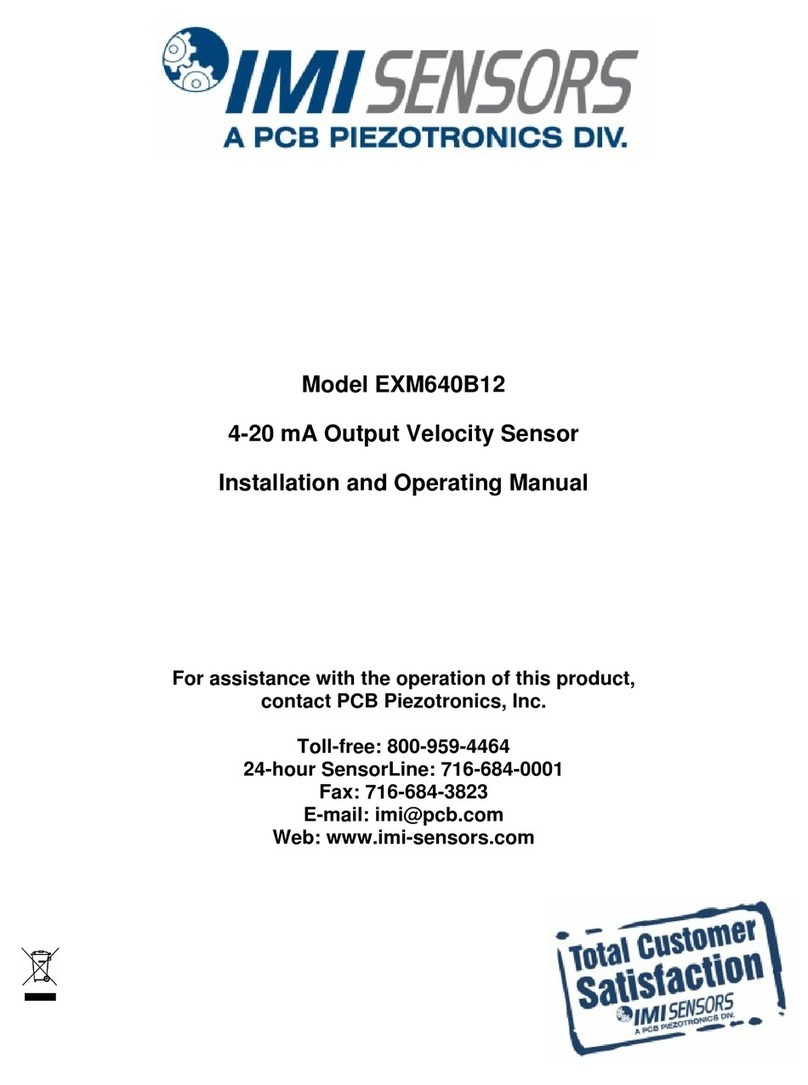
IMI SENSORS
IMI SENSORS EXM640B12 User manual
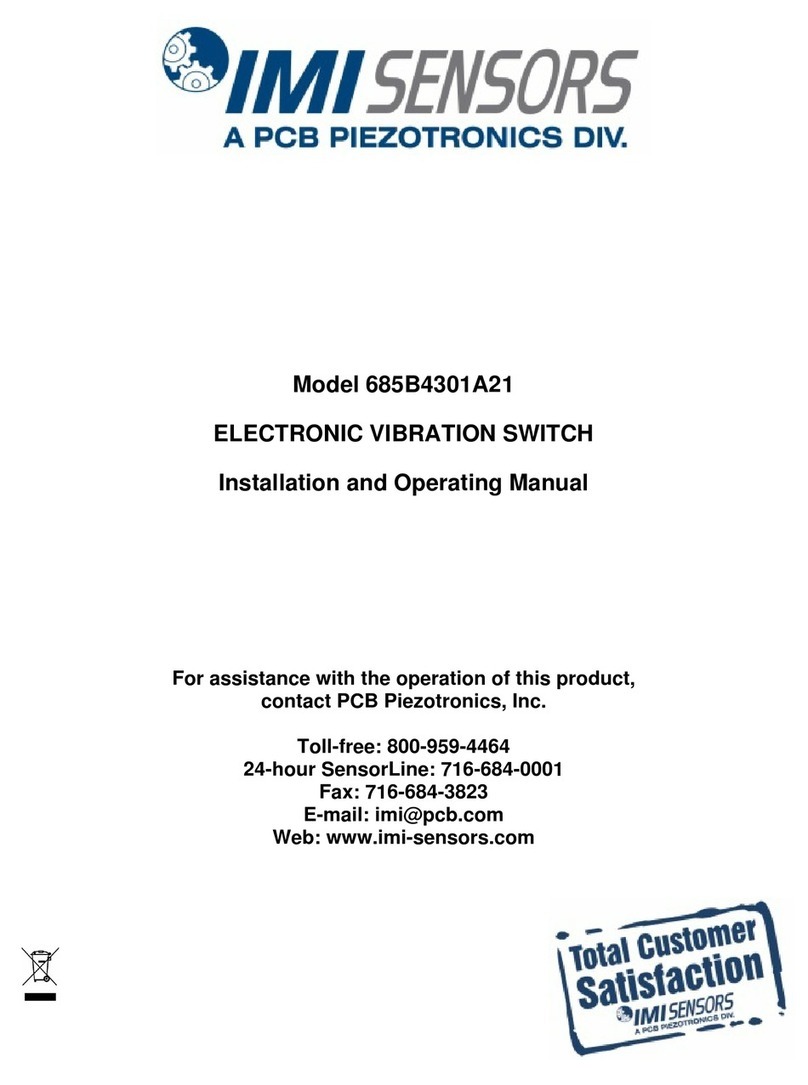
IMI SENSORS
IMI SENSORS 685B-Series User manual
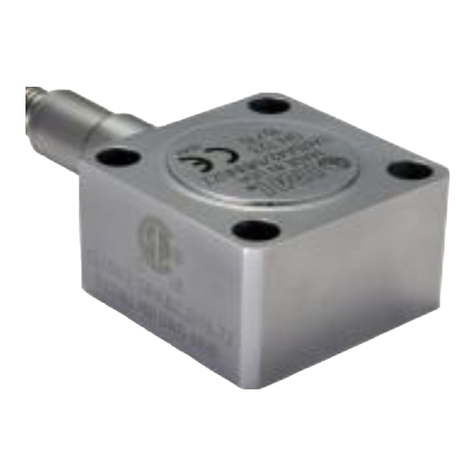
IMI SENSORS
IMI SENSORS EX615A42 User manual
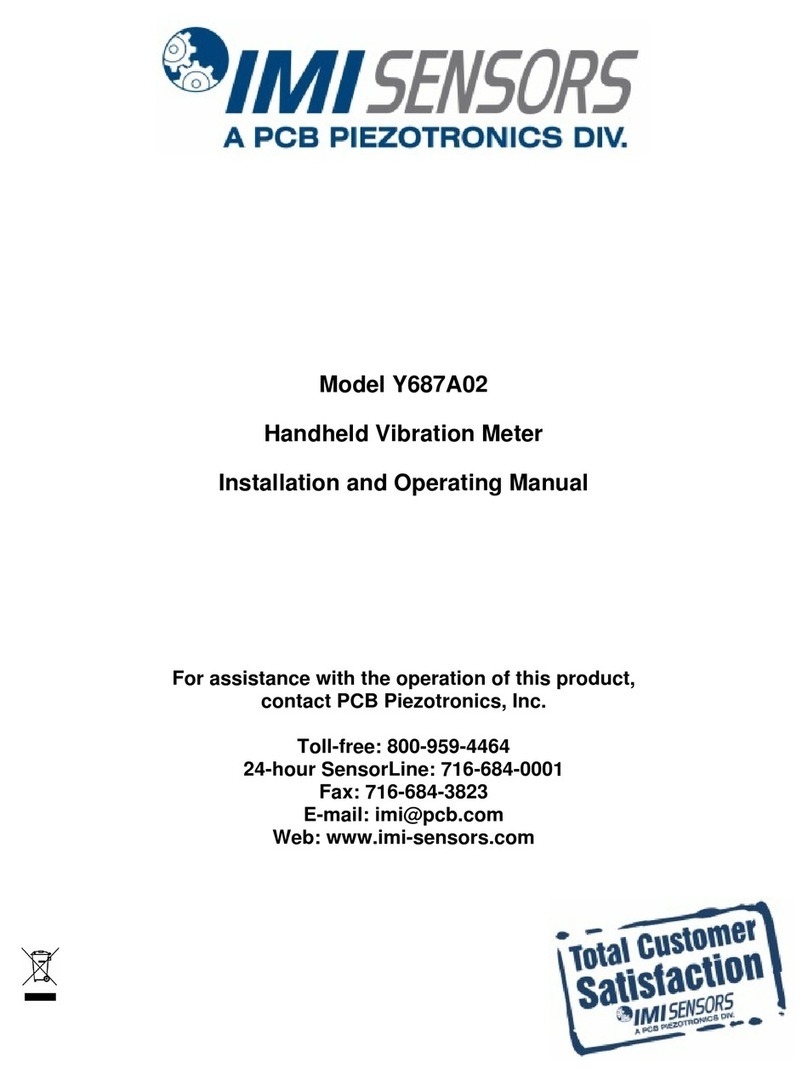
IMI SENSORS
IMI SENSORS Y687A02 User manual
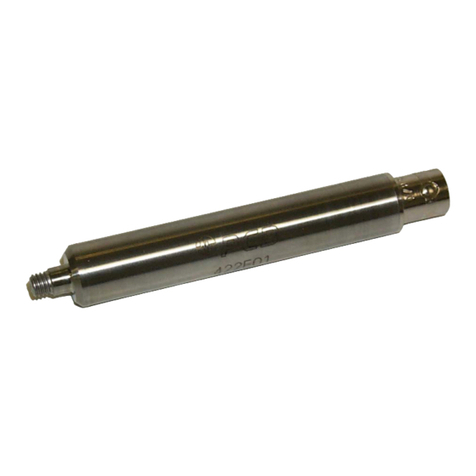
IMI SENSORS
IMI SENSORS 600A03 User manual
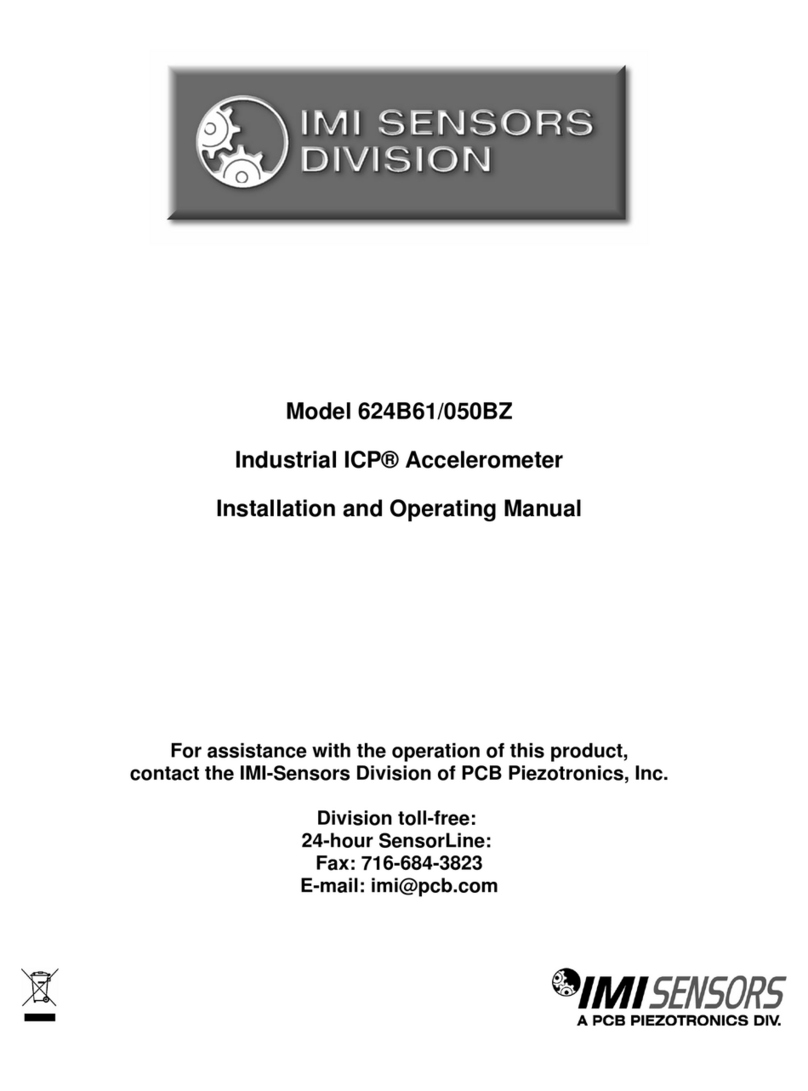
IMI SENSORS
IMI SENSORS 624B61/050BZ User manual
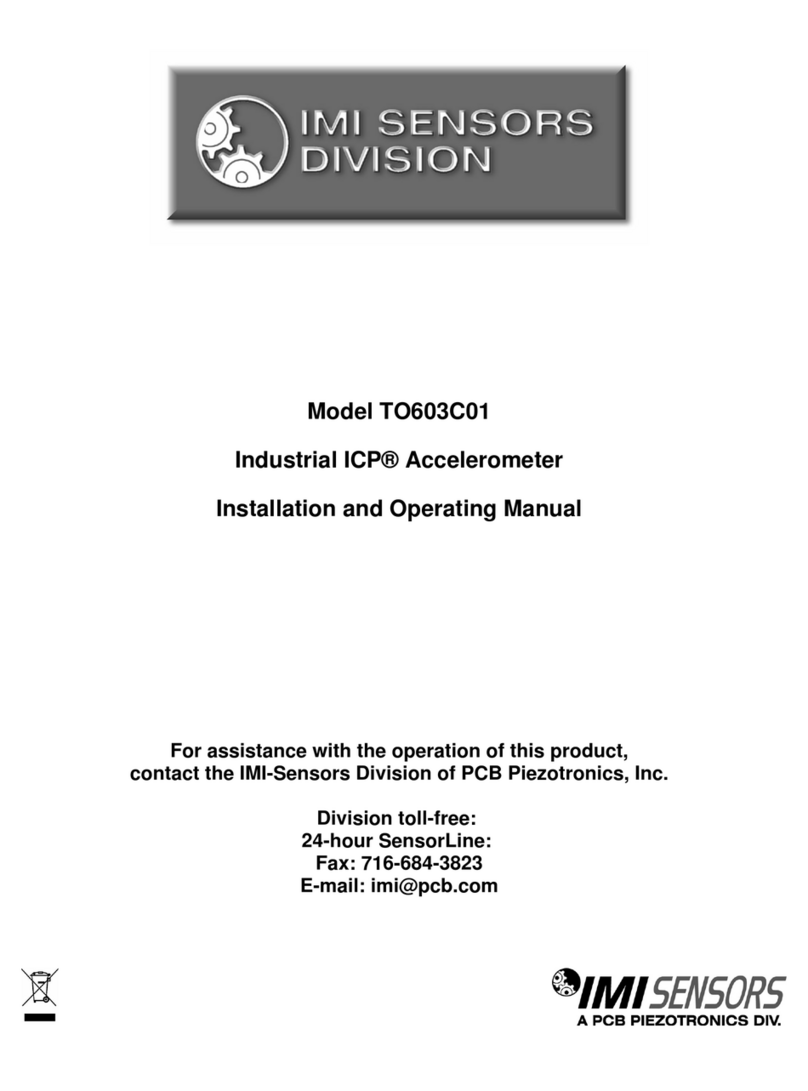
IMI SENSORS
IMI SENSORS TO603C01 User manual
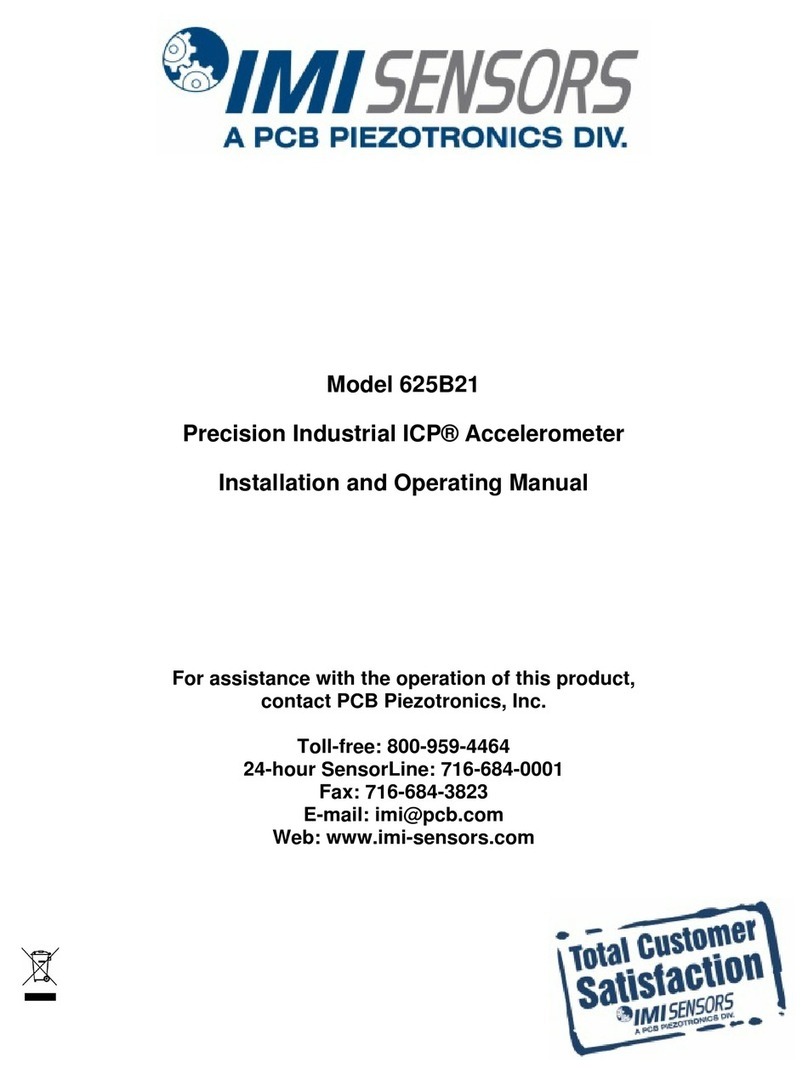
IMI SENSORS
IMI SENSORS 625B21 User manual
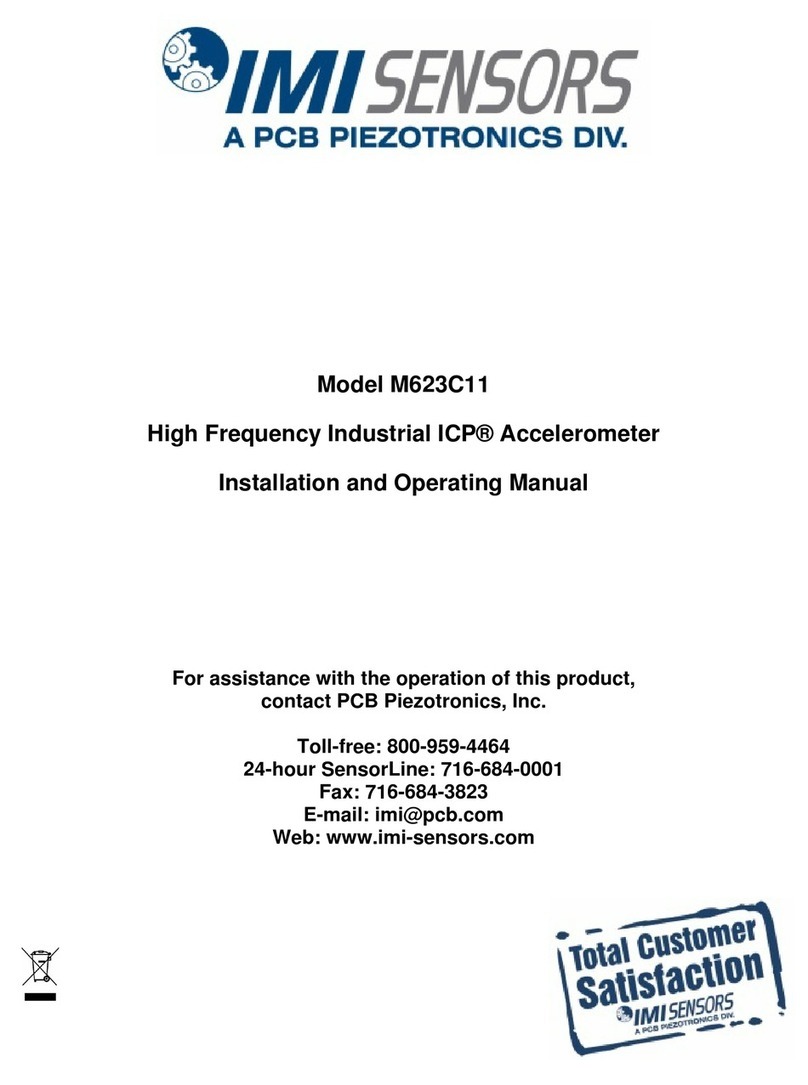
IMI SENSORS
IMI SENSORS PCB Piezotronics M623C11 User manual
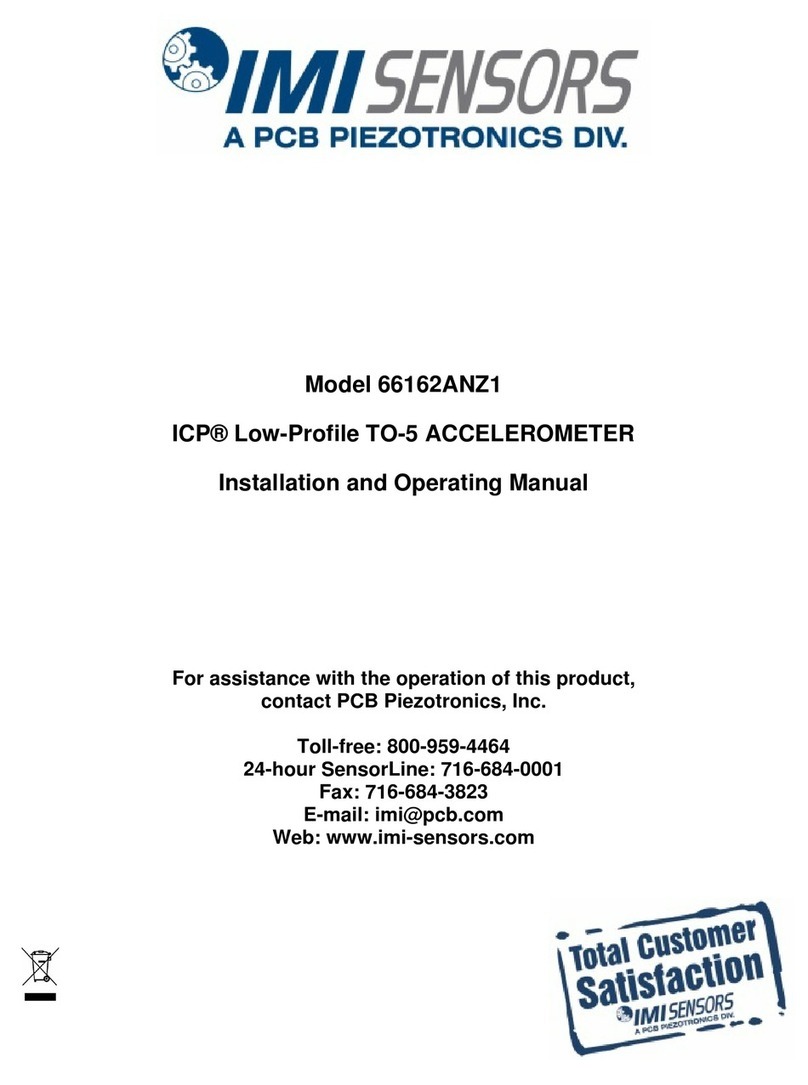
IMI SENSORS
IMI SENSORS PCB PIEZOTRONICS ICP 66162ANZ1 User manual
